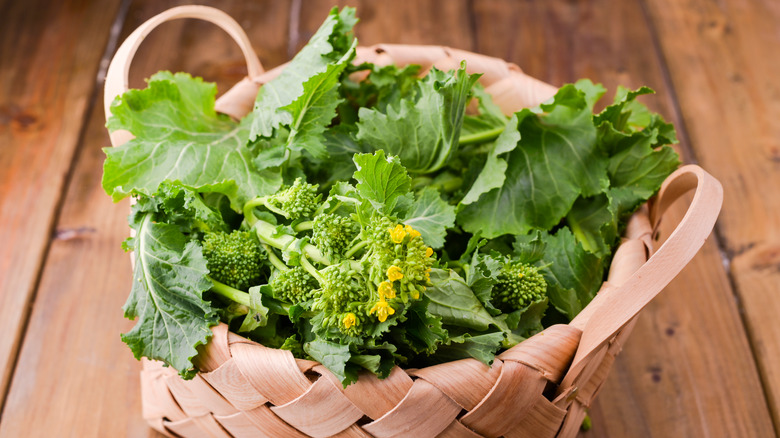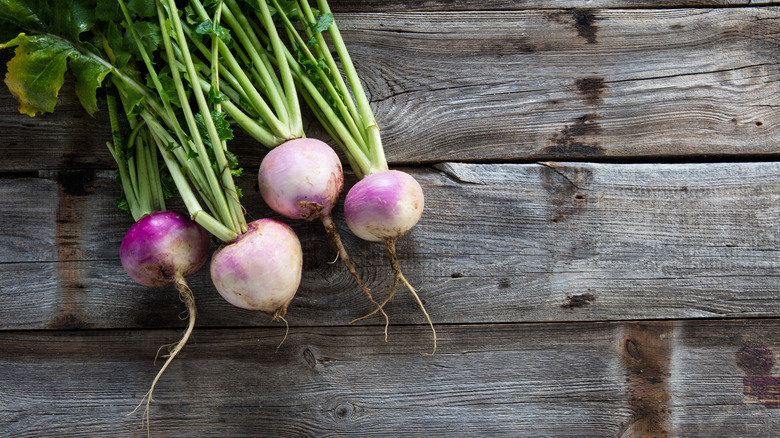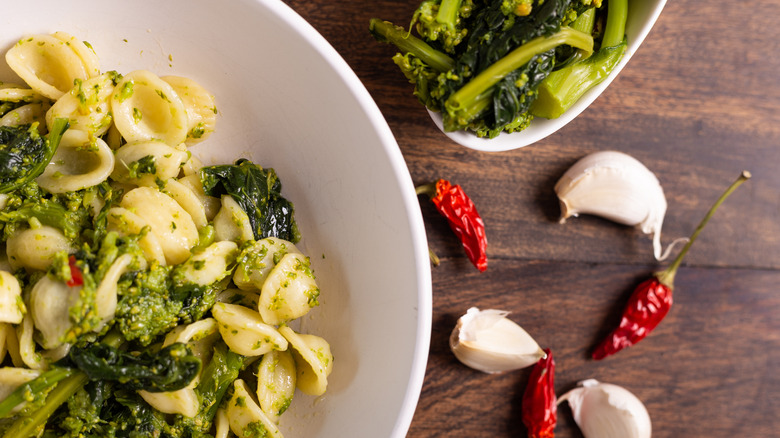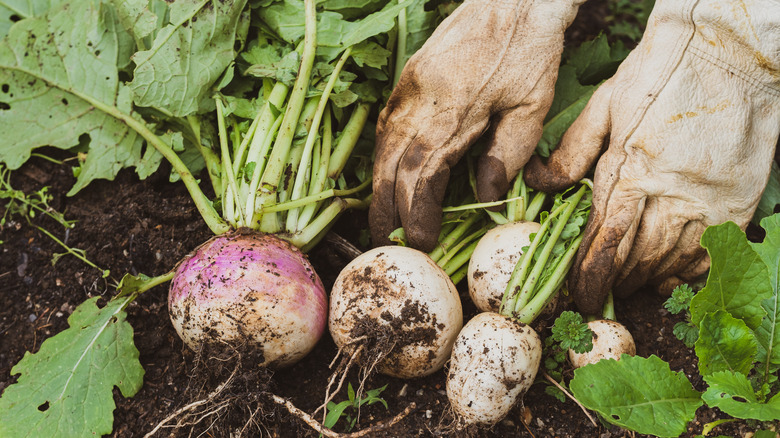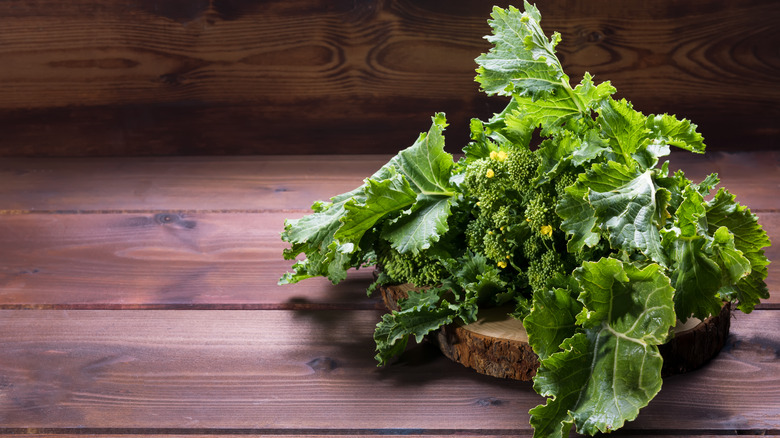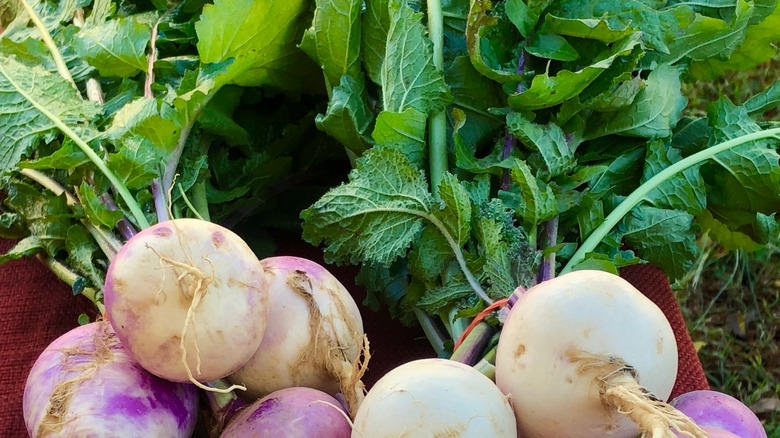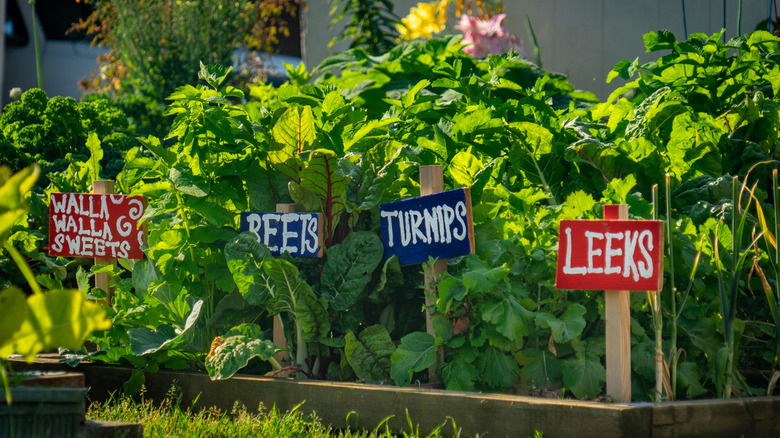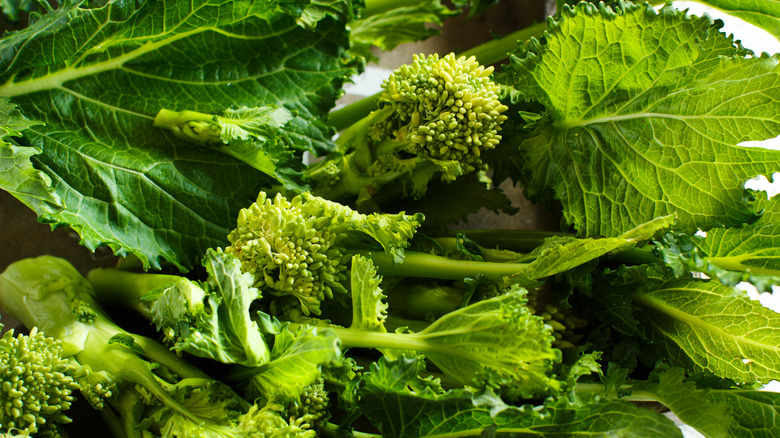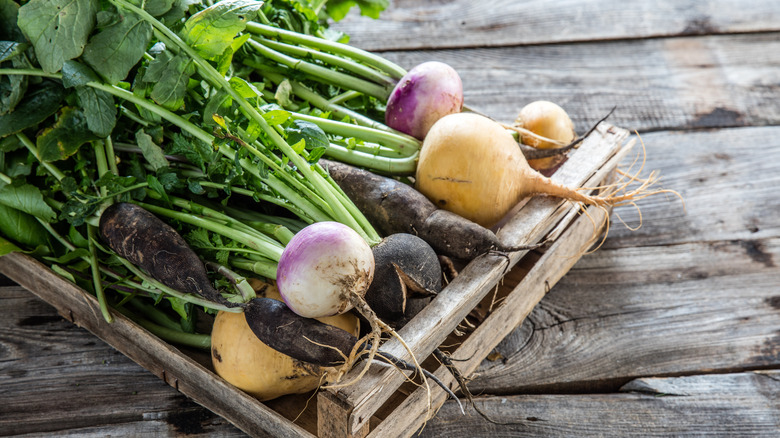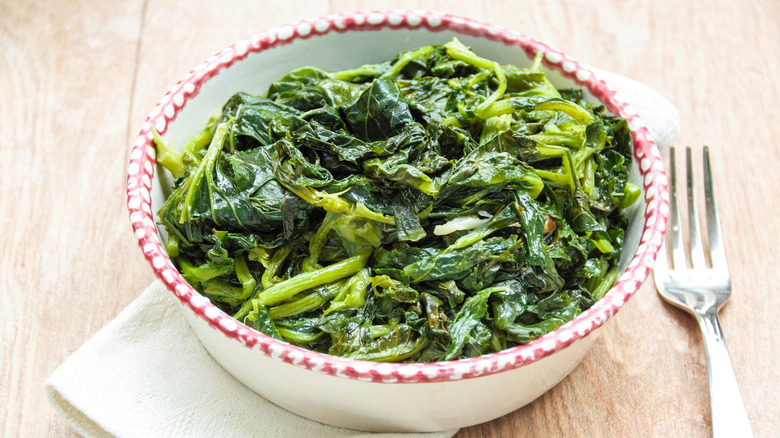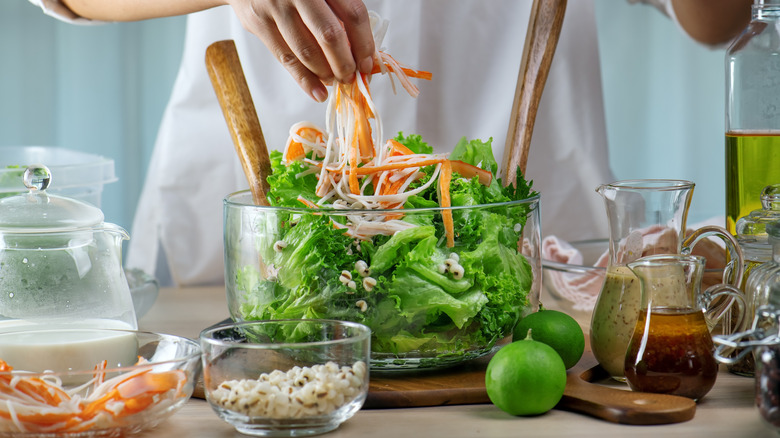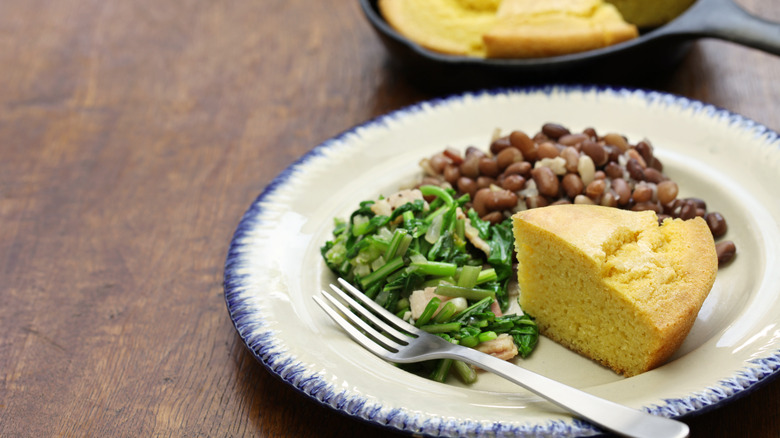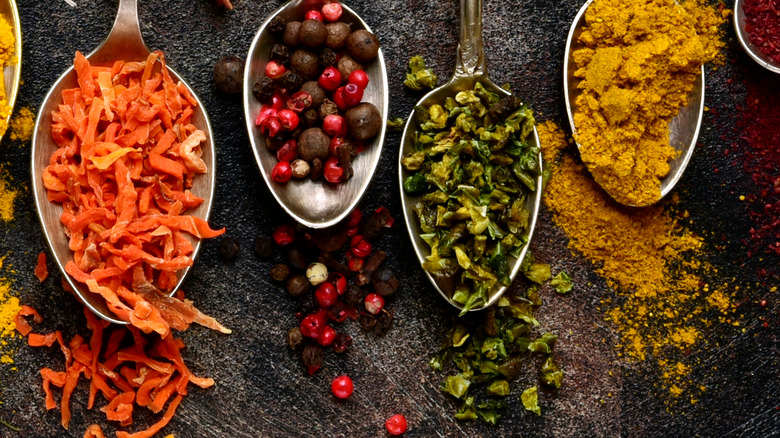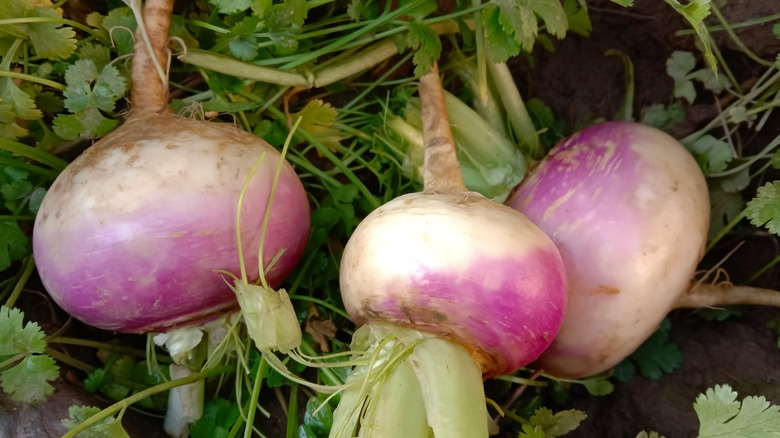Everything You Need To Know About Turnip Greens
Everyone really should make an effort to incorporate greens into their regular diet. It can be tough, though, especially with picky family members, or kids who are more interested in hot dogs than spinach.
Still, it's important: Advanced Health says that leafy greens are packed with all kinds of goodness, and have a positive impact on everything from weight management to bone strength and immune function.
That all includes turnip greens, and here's the thing: There's a good chance many people might not even think of adding turnip greens to the menu. Even if turnips make an occasional appearance mashed or served alongside other seasonal vegetables, the greens — unless you happen to live in the Southern U.S. — are a little more uncommon. Heck, most grocery store turnips come with the greens already removed, and honestly, that's a shame.
So, let's talk about these underrated and underutilized greens, and fill you in on everything you need to know.
What are turnip greens?
Turnip greens are precisely that — the greens that grow from a turnip. Gardening Know How says that they're a part of the Brassica family, but what does that mean?
Turnips — and turnip greens — are also what's called cruciferous vegetables, and according to MasterClass, their family also includes arguably more popular vegetables like kale, wasabi and horseradish, collard greens, cabbage, Brussel sprouts, broccoli, and cauliflower.
It might be a little hard to believe, but these often overlooked vegetables have a long and incredible history. FoodPrint says that Neolithic-era seeds suggest that it's been a staple crop for thousands of years, and they even got a mention in the works of classical writer Pliny the Elder. In the first century BC, he called them one of the most important vegetables the ancient Greeks had, but it was sort of a slow, downhill slide from there, particularly in relatively recent history.
By the 15th century, National Geographic says the term "turnip eater" became a sort of slang term for uneducated country folk, and it was a term even Dickens picked up on. There's a sad connection here, too — because they're fairly easy to grow, turnips and turnip greens became associated with not only the poor, but with one of the staple foods that got scores of people through countless famines and other difficult times, like World War II.
What do turnip greens taste like?
Turnips are just one of those vegetables that it's tough to get excited about, and add in the greens, and it's safe to say that we get it — this might be a tough sell for many families. So, let's talk about one of the most important things to consider: taste.
According to Foods Guy, turnip greens can come with a range of flavors, and they can be surprisingly delicious — especially if you like the flavor profile that comes with other related plants, like radishes, mustard, and horseradish. Turnip greens can be anywhere along the spectrum from sweet to bitter, but here's the thing — they also have a really nice, not-at-all-overwhelming peppery taste, too!
The key to knowing just what you're going to get is the age of the greens. Turnip greens will have a stronger flavor the longer they're left to mature, and when they're harvested later in the season, they'll have a stronger peppery pop, but the sweetness of younger leaves will start to take on a slight bitterness that some people find completely disagreeable.
That's easy to avoid, though: just opt for those young leaves, and that bitterness won't be there yet.
Let's explain the ANDI system and where turnip greens fall
There's a lot of ways to determine what's good and bad for us, and the Aggregate Nutrient Density Index, or ANDI, is one of them. According to Simply Fresh, it's a mathematically-based system that weighs a food's nutrients against the calories it contains. The better the food and the lower the calories, the higher the score — and the higher the score.
The scale goes from 0 — the bad end — all the way up to 1,000, and here's the cool part: Turnip greens are one of the few foods to get a perfect score of 1,000. They're up there with things like Swiss chard, kale, and mustard greens, and let's put this in perspective by looking at other foods we tend to think of as being pretty good for you. Spinach? That comes in at a 707. Cauliflower? That's a 315. Strawberries? A 182. Watermelon? A measly 71.
Shocking, right? Turnip greens do so well because according to Medical News Today, a 55-gram cup contains just 18 calories, but delivers a huge percentage of your daily recommended intake of things like vitamin A, vitamin C, and all of the vitamin K you should be including in your diet.
What are the health benefits of turnip greens?
Now, let's talk about why everyone should consider adding turnip greens to their vegetable lineup: According to Medical News Today, turnip greens come with such serious health benefits that it's honestly pretty shocking that they don't get more attention.
Turnip greens contain high amounts of the vitamins and nutrients that the body needs to keep hair and skin healthy, and at the top of that list is iron. Iron is incredibly important, and there's so much in turnip greens that they're actually considered one of the foods that's great for fighting anemia and an iron deficiency, in part because they contain not only iron, but also the vitamin C that helps the body absorb and use all that iron.
Turnip greens have also been linked to the prevention of osteoporosis — the vitamin K they contain is crucial for bone health — and it's even been suggested that they can help prevent the development of certain types of cancer, as well as diabetes.
It's entirely possible they'll make you feel better, too: In addition to their high fiber content being an invaluable part of keeping your digestion on track, they also contain something called choline, a nutrient linked to things like regulating sleep patterns, improving memory, and reducing chronic inflammation. What's not to love?
Where do you get turnip greens?
Most grocery store turnips are missing their greens, so where is the best place to get them?
FoodPrint says that in season, your local farmers' market is one of the best places to get fresh turnips with the green still attached. Out of season, there's some good news — they say that more and more grocery stores are starting to sell turnips with their greens. You also might want to check the shelves that are just full of greenery as sometimes, you can buy the greens without the root. Opt for bundles of leaves that are bright green and firm, and make sure you leave behind anything that looks wilted, yellowish, or has a slimy texture.
There's another great option here, too, and that's simply to grow your own. Gardening Know How says that not only can turnips be planted and grown in most places at any time from the early spring to the late fall, but they also add that harvesting the greens while they're young will keep the turnip itself from maturing. At the same time, the root will keep producing greens, making it easy to keep a constant supply of fresh turnip greens right at hand.
Turnip greens ... without the turnip?
For anyone who's thinking about growing their own turnip greens, here's some fascinating food for thought: Not all turnips are created equal, and some varieties will grow the turnip greens without the traditional turnip! Pretty cool, right?
SFGate says that while you can grow and harvest turnip greens from any variety of turnip, there are some that put all of their growing power into the greens, instead of developing the root. The aptly-named Alltop, for example, will develop massive turnip greens just a month after the first greens start peeking out of the soil. Shogoin will take a little longer, but the greens of this variety are milder than others, and they tend not to have the fibrous toughness that other types can develop. Another aptly-named variety grown mainly for greens is called Topper, and if you live in a warm climate, this might be the one for you — it's not going to turn bitter and go to seed in the warmth like some varieties might.
Finally, there's Seven Top, which surprisingly doesn't even grow an edible root at all. This one is all about the greens, so if you're looking for a great, window-box option that'll keep you supplied with delicious, healthy, leafy turnip greens for the season, look no further!
Is there a difference between turnip greens and rutabaga greens?
It's entirely possible that you may have heard the terms "turnip" and "rutabaga" used interchangeably, but they're completely different vegetables that happen to look similar. (It also doesn't help that sometimes, a rutabaga can be called a Swede turnip!) Both have a purplish top and they're both from the same family, but turnips are generally smaller than rutabagas, and are white inside where a rutabaga is yellowish.
Their greens are different, too. Turnip greens are lighter and thinner than rutabaga greens, and according to Produce Made Simple, they're usually covered in a light coating of fuzz. Both types of greens are edible, though, so if you like one, you'll probably like the other in spite of a slight difference in flavor. Think of rutabaga greens (pictured) as similar to young turnip greens, and you've got a good idea of what to expect when it makes it to the plate.
How to take the bitterness out of turnip greens
Turnip greens might be good for you, but sometimes, they come with a catch — more mature leaves, like the ones attached to the turnips you might pick up at the farmers' market, can have a bitter taste. Fortunately, there are ways to fix that, says The Kitchn.
For starters, you can make sure you're serving the turnip greens alongside some ingredients that are going to counteract the bitterness. A dash of vinegar or citrus will go a long way, and sweet ingredients will do the same thing. Alternatively, you can remove a lot of bitterness by blanching your greens first.
Stella Culinary says that blanching is a relatively simple process that's used with a number of ingredients, particularly when you want their flavor to be a little milder. Start by salting a pot of water, and once that water is boiling, add the greens. Let them boil for just a short time (how long depends on how soft you want to let them get), then remove the greens and submerge them in ice water to cool them immediately. Not only will a lot of the bitterness disappear, but the rapid cooling will help make sure the greens keep their structure so they can be cooked again without turning into something that's less like a vegetable and more like pudding.
Eating the stem: yay or nay?
One of the great things about turnip greens is that they're not only a green that you can keep harvesting as it regrows throughout the season, but when you're preparing turnips, eating the greens is one small step toward a no-waste lifestyle. But here's a question: What about the stems?
Bon Appétit says no, that turnip greens are one of the leafy greens where you're going to want to remove the stem before you start cooking. They can add an unpleasant, fibrous texture to a dish, and no one wants that. But getting rid of them seems to go against the whole "no waste" thing, right? It doesn't have to!
There are a few ways you can use the stems, too — starting with vegetable stock. Food52 recommends keeping a container of vegetable stems, stalks, and other uneaten parts in the freezer, then spending an hour or two one day simmering the stalks in a pot with some herbs, and straining it all to make a stock that you can then use for almost countless applications.
FoodPrint says that you can also add these into recipes where the fibrous texture isn't going to have the chance to be offensive. Think of blended recipes: Add stems into a pesto or into a smoothie, and you'll get all of the nutrients with none of the yuck.
What are the best ways to cook turnip greens?
Cooking greens — including turnip greens — can be a bit of a challenge, so what should you be doing with them? Harvest to Table suggests a great rule of thumb, which is basically that you can cook turnip greens in pretty much any way you'd cook spinach.
Some winning options include steaming them just long enough that the greens wilt — this is a great way to prepare them for anyone who doesn't like mushy greens or is picky about textures. Don't have much time? Grab a pan and some olive oil, give them a quick sauté, and you've got a super healthy side dish. (Want to make it a little less healthy, but even more delicious? Try using bacon fat!)
Boiling is also an option, and it's also easy. Depending on the texture you're going for, boiling turnip greens down into a brilliant side dish will take between five and 15 minutes, and pro tip? Don't forget to add a dash of salt, and when you serve, add a splash of vinegar.
Yes, you can serve turnip greens raw!
Cooked greens can be a tough sell, we get it. Fortunately, you can definitely eat them raw, and there are a few things to keep in mind here.
As Gardening Know How says, the best turnip greens to eat raw are the ones that are still small. The younger they are, the more mild their flavor will be, and you won't need to worry about cooking out any bitterness. Unfortunately, this also means that your best option for getting some great, raw greens might be to grow them yourself.
Once you have your young turnip greens, there's a ton of options for adding them to a meal. FoodPrint recommends adding them to a salad and mixing them with other greens, and you can also use them alongside or instead of basil if you're whipping up a pesto. It's often said that small changes add up to have big benefits, so you also might want to consider replacing lower-nutrition greens — like iceberg lettuce — with turnip greens. Add them to a wrap, on your favorite sub, hoagie, or sandwich, or use them the next time you grill up some burgers.
Turnip greens are a staple of Southern cooking
Most regions in the U.S. — and countries of the world — have their own favorite ingredients, and turnip greens are a staple of Southern cuisine (via Gardening Know How). That's an important bit of trivia, and it means that if you're wondering how to make the very best turnip greens that will guarantee your family gets behind making this healthy dish a permanent item in the menu rotation, you can look to some traditional Southern recipes that have been perfected over generations.
One of the most popular ways to serve a side of turnip greens is also incredibly easy. Divas Can Cook uses a salty chicken broth for their Southern staple, adding red pepper flakes, onions, bell peppers, garlic, and a dash of liquid smoke for some serious flavor.
That's a healthy version of a long-time favorite. The South Carolina Encyclopedia says that for generations, cooks used pork pieces — particularly ham hocks or fatback — to make a broth for cooking the turnip greens. Usually served as a side, resourceful cooks would make them even more delicious with a dollop of tomato preserves, onion jam, or hot pepper sauce.
Turnip greens can be dried for some neat applications
Sure, turnip greens are great whether they're cooked or raw, but they're also great dried, too!
Summer in a Jar has some great tips on how to dehydrate greens in order to not only extend their shelf life, but make it possible to add all the nutritional goodness to a dish, without having to fight with the family over eating their greens. In a nutshell, you can rinse your greens in lightly salted water, drain, and prep by removing those pesky stems. Then, steam the greens for just a few minutes, then transfer everything into the tray of a dehydrator and dry away.
Just how long it's going to take depends on how much you're drying and the capabilities of your dehydrator, but once you're done, you can store them in bags or jars, preferably in a dry, dark place.
Not only will this extend the shelf life of your greens, but there are a variety of things you can do with dried greens. They can be rehydrated and served as a side just like you would if they were fresh, or they can be added to soups, stews, and smoothies for a nutritional boost — without the questionable texture or the arguments.
You can freeze fresh turnip greens for later
If there's anything that makes a long winter season seem even longer, it's the lack of fresh veggies that go right from the farmers' market (or your own garden) straight to the table. Fortunately, turnip greens can help you out here. While turnip greens might not seem like something that would freeze well, the University of Minnesota Extension, says that they absolutely do.
They recommend blanching the greens first by boiling them for two minutes, then cooling them quickly in an ice bath. Then, put them in freezer-safe containers and pack the greens flat before filling the container with cold water. Leave enough room for the ice to expand, and then just pop them in the freezer. They'll be good for around a year, and the blanching process will help make sure they retain a lot of their flavor when you pull them out to use them — even if it's the middle of winter.
